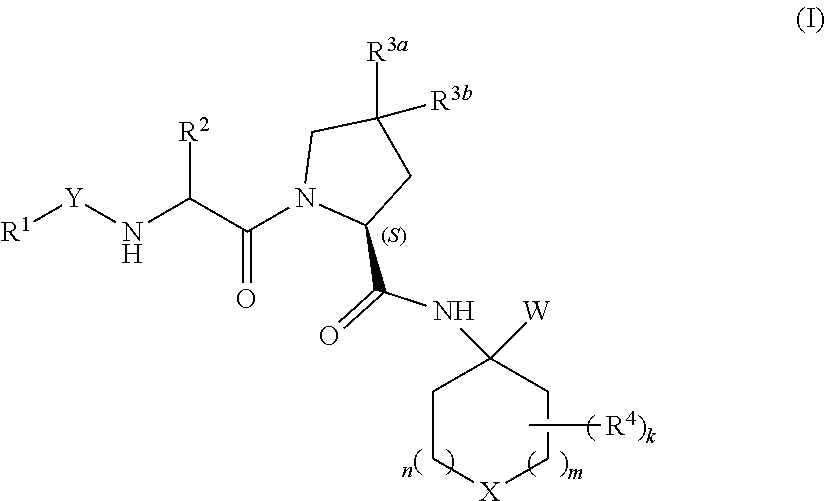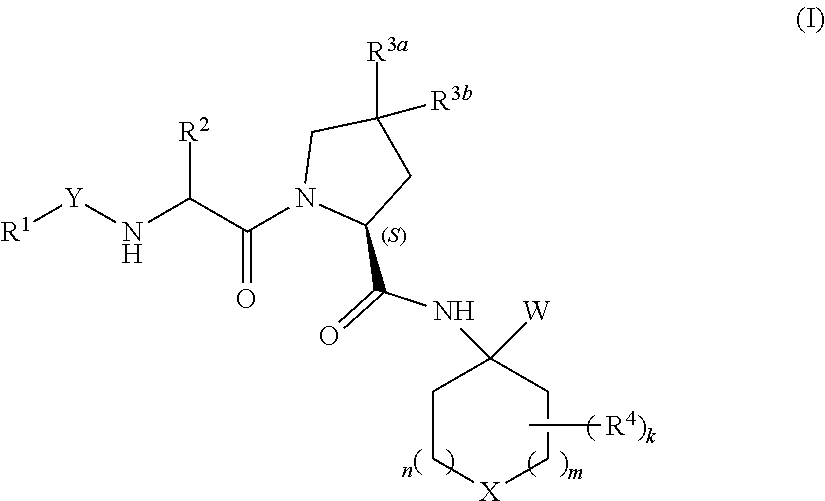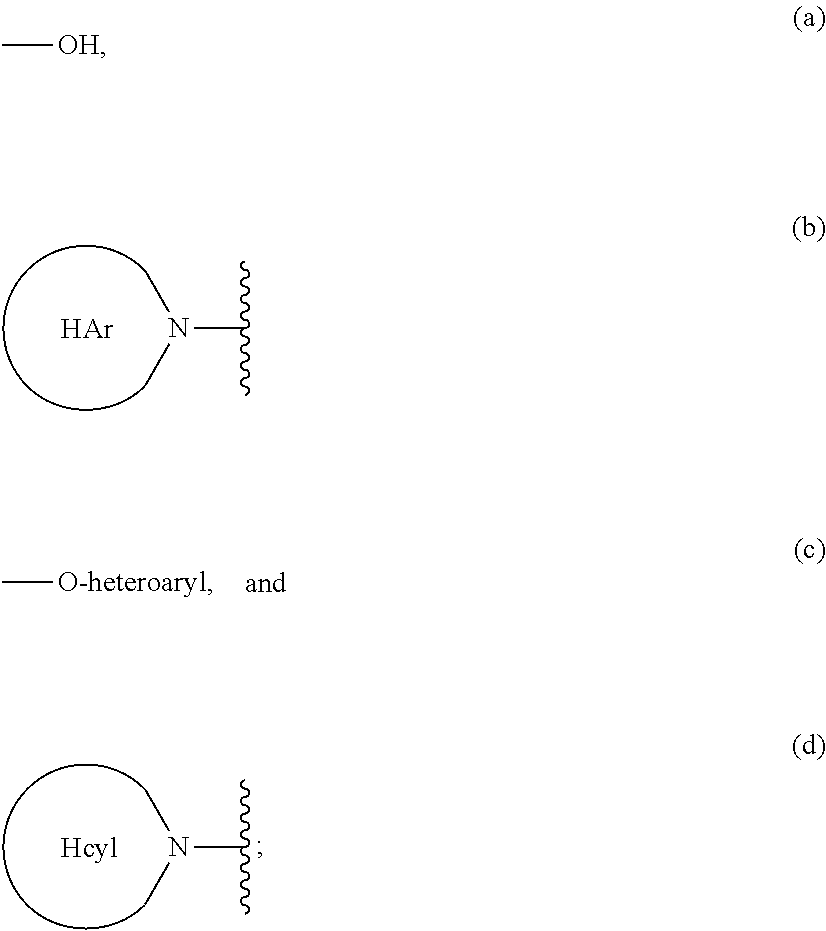Heterocyclic prolinamide derivatives
a technology of heterocyclic prolinamide and derivatives, applied in the direction of organic chemistry, chemical apparatus and processes, drug compositions, etc., can solve the problems of difficulty in distinguishing between iris pigmentation alone and other, increasing the risk of amd, and affecting vision
- Summary
- Abstract
- Description
- Claims
- Application Information
AI Technical Summary
Benefits of technology
Problems solved by technology
Method used
Image
Examples
example 1
l 4-((2S,4S)-1-((R)-2-(2-naphthamido)-3-cyclohexylpropanoyl)-4-(5-(2-hydroxypropan-2-yl)-1H-1,2,3-triazol-1-yl)pyrrolidine-2-carboxamido)-4-(2-amino-2-oxoacetyl)piperidine-1-carboxylate
[0830]
Step 1: Preparation of benzyl 4-((2S,4S)-1-((R)-2-(2-naphthamido)-3-cyclohexylpropanoyl)-4-(5-(2-hydroxypropan-2-yl)-1H-1,2,3-triazol-1-yl)pyrrolidine-2-carboxamido)-4-(2-amino-1-hydroxy-2-oxoethyl)piperidine-1-carboxylate (46)
[0831]The title compound was prepared in a similar manner to Intermediate J, step 1, using Intermediate I and Intermediate A.
Step 2: Preparation of (2S,4S)-1-((R)-2-(2-naphthamido)-3-cyclohexylpropanoyl)-N-(4-(2-amino-1-hydroxy-2-oxoethyl)piperidin-4-yl)-4-(5-(2-hydroxypropan-2-yl)-1H-1,2,3-triazol-1-yl)pyrrolidine-2-carboxamide hydrochloride (47)
[0832]To a degassed solution of compound 46 (222 mg, 0.265 mmol) and 1 M aq. HCl (260 μL, 0.260 mmol) in MeOH (10 mL) was added Pd(OH)2 (44 mg, 0.03 mmol) and the mixture was stirred under a balloon of H2 for 4 hours. The suspensi...
example 2
-((R)-2-(2-naphthamido)-3-cyclohexylpropanoyl)-N-(4-(2-amino-2-oxoacetyl)tetrahydro-2H-pyran-4-yl)-4-(5-(2-hydroxypropan-2-yl)-1H-1,2,3-triazol-1-yl)pyrrolidine-2-carboxamide
[0835]
Step 1: Preparation of (2S,4S)-1-((R)-2-(2-naphthamido)-3-cyclohexylpropanoyl)-N-(4-(2-amino-1-hydroxy-2-oxoethyl)tetrahydro-2H-pyran-4-yl)-4-(5-(2-hydroxypropan-2-yl)-1H-1,2,3-triazol-1-yl)pyrrolidine-2-carboxamide (49)
[0836]To a mixture of Intermediate I (868 mg, 1.58 mmol), Intermediate B (275 mg, 1.58 mmol) and HATU (661 mg, 1.74 mmol) in DMF (4 mL) was added iPr2EtN (550 μL, 3.16 mmol) and the reaction mixture was stirred at 23° C. After 1 hour, this solution was partitioned between water (20 mL) and EtOAc (2×50 mL). The combined extracts were washed with 1 N aq. HCl (20 mL) and then sat. aq. NaHCO3 (20 mL). This extract was dried over MgSO4, filtered and concentrated under reduced pressure. This residue was purified by column chromatography using a RediSep cartridge (80 g, silica gel) eluting with a ...
example 3
-(4-(2-amino-2-oxoacetyl)tetrahydro-2H-pyran-4-yl)-1-((R)-3-cyclohexyl-2-(4-(methylsulfonyl)benzamido)propanoyl)-4-(5-(2-hydroxypropan-2-yl)-1H-1,2,3-triazol-1-yl)pyrrolidine-2-carboxamide
[0838]
[0839]To a mixture of 4-(methylsulfonyl)benzoic acid (Combi-Blocks, CA, catalog #OR-0048) (659 mg, 3.29 mmol), Intermediate J (1.6 g, 2.74 mmol) and HATU (1.46 g, 3.84 mmol) in DMF (6 mL) and DCM (16 mL) was added iPr2EtN (52 μL, 0.3 mmol) and the reaction mixture was stirred at 23° C. for 18 hours. The mixture was partitioned between EtOAc (100 mL) and sat. aq. NaHCO3 (100 mL) and the aqueous layer was extracted with EtOAc (3×100 mL). The combined extracts were washed with brine (100 mL), dried over MgSO4, filtered and concentrated under reduced pressure. This residue was purified by column chromatography using a RediSep Gold cartridge (120 g, silica gel) eluting with a 0-12.5% MeOH in DCM gradient. The desired fractions were concentrated under reduced pressure to provide the title compound ...
PUM
| Property | Measurement | Unit |
|---|---|---|
| pH | aaaaa | aaaaa |
| flow rate | aaaaa | aaaaa |
| time | aaaaa | aaaaa |
Abstract
Description
Claims
Application Information
 Login to View More
Login to View More - R&D
- Intellectual Property
- Life Sciences
- Materials
- Tech Scout
- Unparalleled Data Quality
- Higher Quality Content
- 60% Fewer Hallucinations
Browse by: Latest US Patents, China's latest patents, Technical Efficacy Thesaurus, Application Domain, Technology Topic, Popular Technical Reports.
© 2025 PatSnap. All rights reserved.Legal|Privacy policy|Modern Slavery Act Transparency Statement|Sitemap|About US| Contact US: help@patsnap.com



